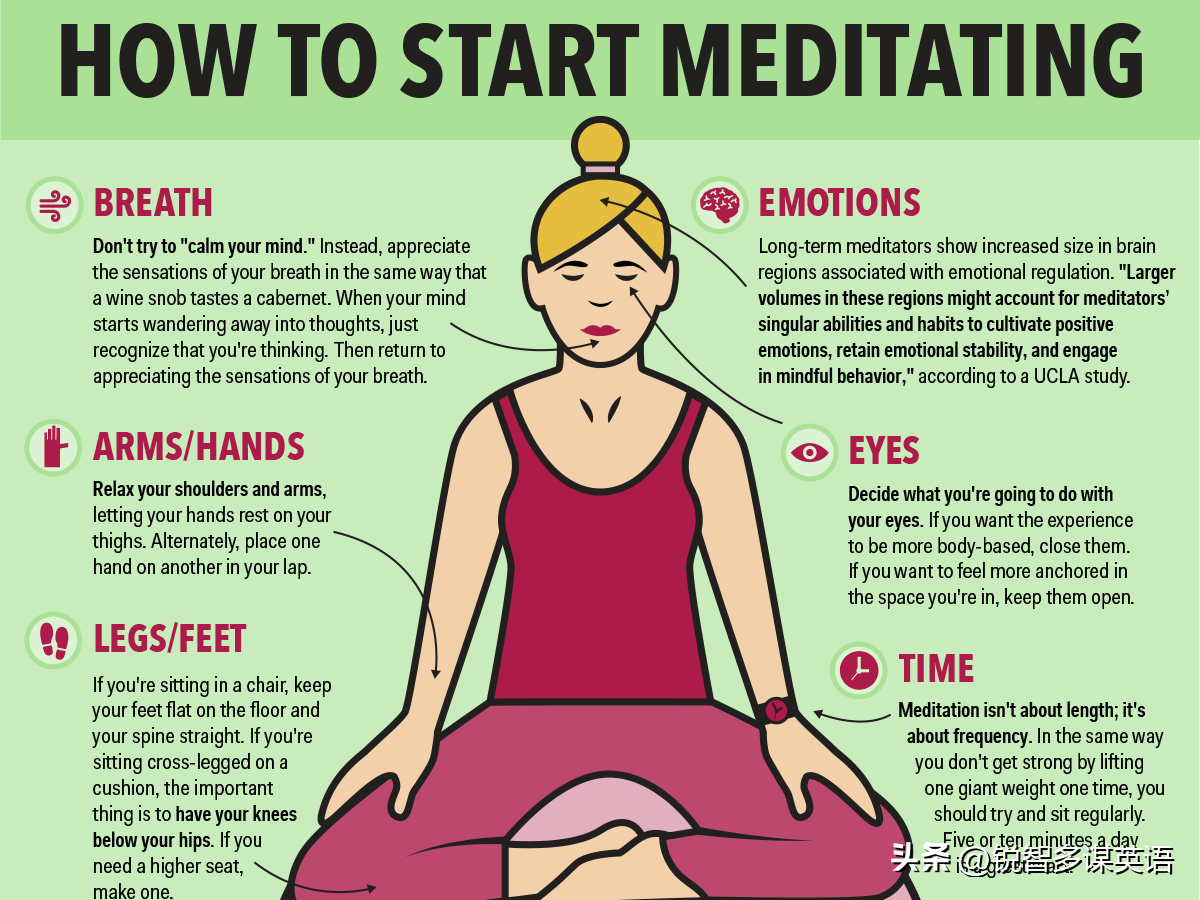What is meditation?
Putsimply, meditationisatoolforstressrelief, Fletchersays, addingthatbyrelievingstress, you'resettingyourselfuptobeabletoperformatthetopofyourgame. “Ibelievewemeditatetogetgoodatlife, nottogetgoodatmeditation,” shesays. Manypeoplehavethemisconceptionthatmeditationisaboutfocusingonthepresent, butFletcheractuallyconsidersthattobemindfulness. Meditation, ontheotherhand, isaboutgettingridofallofthestressthebodyhasstoredfromthepast.
简单地说,冥想是一种缓解压力的工具,弗莱这样定义“冥想”。她又补充说到,冥想是通过缓解压力,让自己在冥想中发挥出最佳状态。她说:“我相信我们冥想是为了更好地生活,而不是为了更好地冥想。”很多人都有一种误解,认为冥想是专注于当下,但弗莱彻实际上认为这是“正念减压法”。另一方面,冥想是为了消除身体过去储存的所有压力。
How to meditate? 如何进入冥想状态?
1) Take a seat 就坐
Find place to sit that feels calm and quiet to you. 找一个自我感觉僻静之处就坐。
2) Set a time limit 设定冥想时间
If you’re just beginning, it can help to choose a short time, such as five or 10 minutes. 如果处于冥想初级阶段,可设定5-10分钟。
3) Notice your body 关注自身坐态
You can sit in a chair with your feet on the floor, you can sit loosely cross-legged, you can kneel—all are fine. Just make sure you are stable and in a position you can stay in for a while.
你可以坐在椅子上,双脚放在地板上,你可以松松地盘腿坐着,你也可以跪着,这几个坐姿都有可以。只需确保你身体固定坐直,处于一个可以停留一段时间的姿势。
4) Feel your breath 让可以感受到自我的呼吸
Follow the sensation of your breath as it goes in and as it goes out.
跟着自身感觉,感知呼吸的气流进出。

5) Notice when your mind has wandered 注意,当你的注意力开小差时及时调整状态
Inevitably, your attention will leave the breath and wander to other places. When you get around to noticing that your mind has wandered—in a few seconds, a minute, five minutes—simply return your attention to the breath.
不可避免地,你的注意力会离开你的呼吸,转移到其他地方。当你注意到你的大脑在几秒钟、一分钟、五分钟内走神时,只需将注意力重新转移到呼吸上。
6) Be kind to your wandering mind 善待你游离不定的思维
Don’t judge yourself or obsess over the content of the thoughts you find yourself lost in. Just come back.
不要评判自己的行为,也不要沉迷于让你游离不定的所思所想。调整思维就行。
7) Close with kindness 心怀善念,闭上双眼
When you’re ready, gently lift your gaze (if your eyes are closed, open them). Take a moment and notice any sounds in the environment. Notice how your body feels right now. Notice your thoughts and emotions.
当你准备好了,轻轻抬起你的眼睛(如果你的眼睛是闭着的,也可睁开)。花点时间注意环境中的任何声音。注意你的身体现在的感觉。注意你的想法和情绪。

A Look at the Benefits of Meditation 管窥冥想带来的益处
Meditation establishes a secure connection between our internal and external worlds. It awakens the body and benefits all aspects of the conscious and subconscious layers of the mind. Out of the numerous perks that meditation gives, a few are listed below.
冥想在我们身体的内部和外部世界之间建立了一种安全的联系。它唤醒了我们的身体,让大脑的意识和潜意识层的各个方面受益。在冥想带来的众多好处中,通过以下好处可以管中窥豹。
1. Meditation enhances empathy 冥想增强共情心理
Loving-kindness or compassion meditation fires neural connections to brain sites that regulate positive emotions like empathy and kindness. The deep state of flow that meditation induces builds social connectedness and make us more affectionate and amicable as a person.
仁爱或共情冥想激发神经连接到大脑部位,调节积极情绪,如同理心和善良。冥想引发的深层流动状态建立了社会联系,并使我们作为一个人更加亲切友好。

2. Meditation improves cognition 冥想提升认知水平
Researchers agree that an excellent way for professionals to increase the likelihood of success is to keep meditation practice as a part of their daily routine. Studies have revealed that both transcendent and mindful meditation practices improve the brain’s problem-solving and decision-making strategies, which can bring a desirable shift in our professional life.
研究人员一致认为,专业人士提高成功可能性的一个好方法是将冥想练习作为日常生活的一部分。研究表明,超越冥想和正念冥想都可以改善大脑的问题解决和决策策略,这可以给我们的职业生活带来理想的转变。

3. Meditation is a natural stress stabilizer 冥想是一种天然的压力稳定器
Stress is the body’s response to unforeseen adversities. Encountering immediate threats increase the level of cortisol, or stress hormone in the body, and activates the Autonomic Nervous system, which is responsible for fight-or-flight responses. Brain studies of regular meditators revealed that they have lower cortisol level in their brains, which explains their resilience and insightful nature.
压力是身体对意外逆境的反应。遇到直接威胁会增加体内皮质醇或应激激素的水平,并激活负责战斗或逃跑反应的自主神经系统。对经常冥想者的大脑研究表明,他们大脑中的皮质醇水平较低,这解释了他们的韧性和洞察力。

4. Meditation promotes emotional health and wellbeing 冥想促进情绪健康和幸福感
Studies have shown that meditation improves self-image and self-worth. When we meditate, we get a clear picture of our mind and become aware of the thoughts that drive our emotions and actions at the moment.
研究表明,冥想可以改善自我形象和自我价值。当我们冥想时,我们对自己的思想有了清晰的了解,并意识到当下驱动我们情绪和行动的思想。
A large-scale study found that regular meditation decreases the likelihood of developing depression and mood-related disorders (Jain, Walsh, Eisendrath, Christensen, & Cahn, 2015). Besides some forms of meditative practices which also promoted positive thinking, as researchers stated, and could improve the overall emotional health of an individual.
一项大规模研究发现,定期冥想可以降低患抑郁症和情绪相关疾病的可能性(Jain,Walsh,Eisendrath,Christensen,以及Cahn于2015联合研究成果)。除此之外,正如研究人员所说,一些形式的冥想练习也能促进积极思考,并能改善个人的整体情绪健康。

5. Meditation increases attention by inducing a state of flow 冥想通过诱导流动状态来增加注意力
Have you noticed how meditation absorbs you into the moment? Mindful awareness comes naturally to us when we meditate, and we reach ‘flow’ state where our mind is in complete harmony with itself. A study on the effects of an eight-week mindful meditation course found that people who are regular meditation practitioners had heightened attention and concentration span.
你有没有注意到冥想是如何吸引你进入这冥想这一境界的?当我们冥想时,我们自然而然地就会意识到,我们达到了“意识流动”状态,在这种状态下,我们的思想与自己完全和谐。一项关于八周冥想课程效果的研究发现,经常练习冥想的人注意力和集中时间都会提高。
Even people who meditated for short durations showed more focus than individuals who did not meditate at all (Jha, Krompinger, & Baine, 2007).
即使是短暂冥想的人也比完全不冥想的人表现出更多的专注力(Jha,Krombinger与Baine于2007年联合研究成果)。

6. Meditation and Pain 冥想与减缓疼痛的关系
A study by the National Center for Complementary and Integrative Health (NCCIH) found that mindful meditation reduces pain sensations in the body without using the brain’s natural opiates (Cherkin et al., 2016).
国家营养补品和综合健康中心(NCIH)的一项研究发现,正念冥想在不使用大脑天然鸦片的情况下减少了身体的疼痛感(Cherkin等人于2016年研究成果)。
The research suggested that combining meditation practices with medication for treating pain conditions like osteoarthritis, headaches, and other chronic pains can be useful for providing long-term remedies.
研究表明,将冥想练习与治疗骨关节炎、头痛和其他慢性疼痛等疼痛病症的药物相结合,可以有效地提供长期治疗。
7. Meditation and diseases 冥想与疾病治疗的关系
The NCCIH in the US, has conducted studies to explore the impact of meditation on disorders like:
美国国家营养补品和综合健康中心(NCIH)进行了研究,探讨冥想对以下疾病的影响:
Most of their research and reviews show that committing to a daily practice improves the overall quality of life, and has long-term benefits for staying emotionally and physically healthy. Furthermore, studies show that meditation had similar effects as medications in treating depression, anxiety, and other emotional problems.
他们的大多数研究和评论表明,坚持每天的冥想锻炼可以提高整体生活质量,并对保持情绪和身体健康有长期益处。此外,研究表明,冥想在治疗抑郁症、焦虑和其他情绪问题方面,与药物具有相似的效果。
8. Meditation and Irritable Bowel Syndrome (IBS) 冥想与肠易激综合征的关系
Studies on the impact of meditation on Irritable Bowel Syndrome was initially conducted by the American College of Gastroenterology in 2014, with no significant establishments. Later, some studies on women with severe IBS symptoms showed that when they practiced mindful meditation regularly for two months, their symptoms significantly reduced.
关于冥想对肠易激综合征的影响的研究最初由美国胃肠病学学院于2014年进行,没有任何重要机构参与。后来,一些对患有严重肠易激综合征(IBS)症状的女性的研究表明,当她们定期练习两个月的冥想时,她们的症状明显减轻。
Meditation practice helped in reducing the anxiety associated with IBS and improved the individual’s quality of life to a large extent (Gaylord et al., 2011).
冥想练习有助于减少与肠易激综合征(IBS)相关的焦虑,并在很大程度上改善了个人的生活质量(Gaylord等人2011研究成果)。

限 时 特 惠: 本站每日持续更新海量各大内部创业教程,一年会员只需98元,全站资源免费下载 点击查看详情
站 长 微 信: lzxmw777






